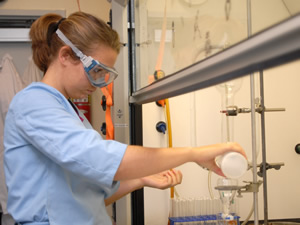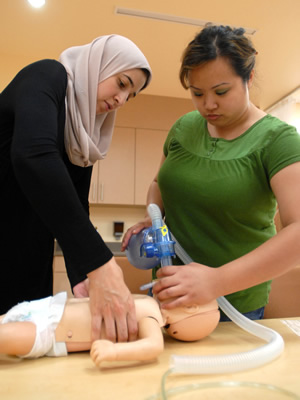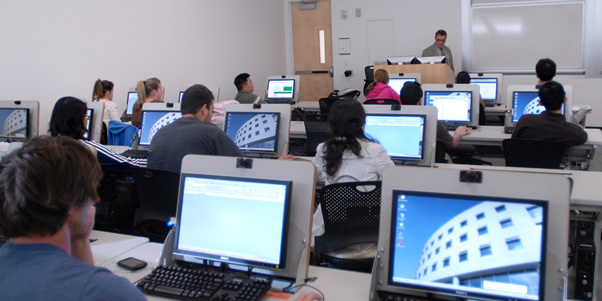Evolution of a University
Cal State Fullerton's Degrees, Courses and Students Change with the Times
December 16, 2008
By Valerie Orleans
During the Cold War, students could enroll in Russian language classes. Today, Arabic and Persian have replaced Russian in the course catalog. Seventies-era students could major in astronomy, but not computer science. Likewise, there weren’t yet animation classes in the arts or social media in communications.
Cal State Fullerton’s course offerings have always been a reflection of world issues and new advances. Each year, the eight colleges on campus analyze courses — making determinations on which ones to keep, add, adapt or drop.
Most Popular Majors
Based on trends in the distribution of degrees awarded, the most popular areas of study at Cal State Fullerton in 2006-07 were accounting, business management, marketing, finance, child and adolescent studies, communications, criminal justice, liberal studies and psychology.

In the College of Natural Sciences and Mathematics, biological science and math have been the two largest departments since the 1960s. Pictured here is student Amanda Cook-Sneathen working in the lab. Photo by Kelly Lacefield
Future Teachers and Technology
When it comes to educating future teachers, many of CSUF's first students, from decades ago, would be surprised by some of the curriculum changes and the emphasis on educational technology and knowledge of K-12 content standards.
"While students continue to seek elementary education credentials, there also is a need for qualified secondary education teachers, with a particular need for math and science, and an ongoing need for special education," said Carmen Zuniga Dunlap, associate dean of the College of Education. "While females still outnumber males in the profession, more men are now pursuing teaching careers, and an increasing number of women now seek administrative credentials."
Replacing Astronomy
Some majors remain popular year after year. In the College of Natural Sciences and Mathematics, biological science and math have been the two largest departments since the ’60s. Although the Physics department no longer offers an astronomy major, Miurtadha Khakoo, department chair, explains that a replacement course, ‘Origins of the Universe,’ was added when Astronomy was dropped from the catalog.
Eco-conscious Degrees
In the College of Engineering and Computer Science, civil and environmental engineering is the No. 1 major, followed by electrical engineering. And, the number of students wanting to major in computer science has grown to such proportions that its name now is reflected in the title of the college.
“The market often drives students in choosing their majors,” said Dean Raman Unnikrishnan. “Although traditional engineering disciplines remain strong, environmental engineering is receiving a lot more attention from students who are more eco-conscious.”
While the dot-com debacle made some students more cautious about computer science, contemporary technological advances have students once again electing to choose these majors.
European Connection
Humanities and Social Sciences have posted increases in criminal justice, English and sociology majors, respectively — with more men taking criminal justice classes and more women taking liberal studies courses. And the gathering strength of the European Union prompted the addition of a major in European Studies.

Years ago, Cal State Fullerton considered eliminating the nursing program. Today, it is one of the fastest growing programs on campus. Pictured in the nursing simulation lab are students Amy El-Akabawl, left, and Caroline Serrano. Photo by Kelly Lacefield
Healthy Growth
Similarly, the College of Health and Human Development owes its origins to the general growth of health-related fields.
"Each of the departments within the college has experienced numerous changes over the years and currently looks vastly different from the original programs," said Kathy Koser, associate dean of the College of Health and Human Development.
Years ago, the university considered eliminating the nursing program and today it is one of the fastest growing programs on campus. In the past, students receiving a degree in physical education primarily taught and coached in the public schools. Today’s students receive degrees in kinesiology and choose concentrations in clinical exercise science, fitness and health promotion, gerokinesiology, sports studies or teacher education or a bachelor of science degree in athletic training.
The child and adolescent development degree now offers options in early childhood development, elementary school settings, adolescent/youth development and family and community contexts. New to the campus are the master in public health degree and the master in social work. In addition there are numerous changes to the master’s degree in counseling and the bachelor of science in human services.
Finance Soaring

The Steven G. Mihaylo College of Business and Economics reports the number of its business majors with accounting and finance concentrations is on the rise. Photo by Kelly Lacefield
The Steven G. Mihaylo College of Business and Economics reports the number of business majors with accounting and finance concentrations is on the increase. And, despite the recent drop in the real estate market, Mark Stohs, associate dean of the college and professor of finance, believes the popularity of the finance emphasis may be due to students who hope to obtain jobs in the insurance industry.
“In business, I think our general approach has been to provide a basic and fundamental program,” Stohs said. “We are always developing new classes and programs, with the latest launch being a concentration in entrepreneurship.”
Lasting Arts
“Between 40 and 50 years ago, the fine arts dominated the majors here,” said Larry Johnson, chair and professor of art in the College of the Arts who earned his bachelor’s and master’s degrees in art as a Cal State Fullerton student during the ‘70s. “There was a strong interest in the crafts areas of metalsmithing, woodworking, weaving and so on, along with a robust drawing and painting program. In the late ‘70s, graphic design majors began to grow, eventually overtaking all other concentrations to become the largest program area. The introduction of computers to design education in the early ‘80s ensured continued interest.
“In the ‘80s and ‘90s, successful feature animation projects at Disney and other major studios fueled a demand for creative talent with a strong foundation in figurative drawing skills. In the 2000s, we introduced digital to our more traditional or classical hand-drawn animation programs,” Johnson said.
Theatre and dance also draws students, according to Susan Hallman, chair and professor of theatre and dance. “The bachelor of fine arts in musical theatre is by far the most popular major.”
The Music Department has grown by more than 15 percent in the last year, according to Marc Dickey, chair and professor of music. While the department is known for its rigorous professional program, it also has developed programs to train public school music educators as well. The department is a major producer of piano teachers based on its piano pedagogy program.
Telling Stories Online
With the advent of online publications, students in the university’s College of Communications are focusing more of their energies on online methods of communication.
"What we have seen is a convergence of sorts," said Tony Fellow, chair and professor of communications. "For example, today's advertising, journalism and public relations students must learn to tell a story, tell it across various media and learn how to market that story.
"The internet and the information explosion it has wrought has changed the way we learn about the world, products, issues and people," Fellow said, "and it has a tremendous impact on the social and political nature of this nation in particular. Today's students must know how to use and harness the power of the new media."
Over the years, the university's proximity to many of Southern California’s tourist attractions led to a new concentration on entertainment and tourism studies, established as a joint program between the colleges of Art, Business and Communications. As our world grows increasingly smaller based on the new technologies available to us, there is more interest in the college’s programs in intercultural communications.
The Changing Face of the Student Body
When Cal State Fullerton offered its first classes, the overwhelming majority of students were white, reflecting not only the ethnicity of the majority of the county’s population at the time but the higher economic status, which would allow students to study for a college education.
About half a century later, the population of Cal State Fullerton better represents the county population as a whole: 28 percent of students are Latino, 22 percent are Asian, 4 percent are African American. Some of the change is due to the changing demographics of Orange County but some is attributed to the university’s outreach programs that encourage and support underrepresented groups on campus.
Debra Cano Ramos, Russ L. Hudson, Paula Selleck, Pamela McLaren and Mimi Ko Cruz contributed to this story.


